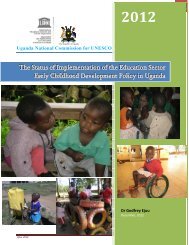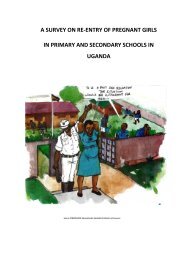Download Pdf - Ministry of Education and Sports
Download Pdf - Ministry of Education and Sports
Download Pdf - Ministry of Education and Sports
Create successful ePaper yourself
Turn your PDF publications into a flip-book with our unique Google optimized e-Paper software.
103<br />
Figure 4.34: Enrolment in all primary schools (2000 – 2012)<br />
Enrolment in Millions<br />
9<br />
8<br />
7<br />
6<br />
5<br />
4<br />
3<br />
2<br />
1<br />
0<br />
2000 2001 2002 2003 2004 2005 2006 2007 2008 2009 2010 2011 2012<br />
Total 6,559,013 6,900,916 7,354,153 7,633,314 7,377,292 7,223,879 7,362,938 7,537,971 7,963,969 8,297,780 8,374,648 8,098,177 8,317,420<br />
Male 3,395,554 3,528,035 3,721,135 3,872,589 3,732,928 3,642,568 3,692,242 3,779,338 3,987,160 4,150,037 4,179,248 4,039,734 4,161,057<br />
Female 3,163,459 3,372,881 3,663,018 3,760,725 3,644,364 3,581,311 3,670,692 3,758,633 3,976,819 4,147,743 4,195,400 4,058,443 4,156,363<br />
Year<br />
Source: EMIS 20002012<br />
Primary school enrolment has been increasing over the last ten years. In 2000, a total <strong>of</strong> 6.5 million<br />
children were enrolled in primary school. By 2010, the enrolment had increased to over 8 million<br />
children, an increase <strong>of</strong> 28% (23% male; 33% female). The 2012 annual school census exercise revealed<br />
that a total <strong>of</strong> 8.3 million children were enrolled in school. Consequently, Ug<strong>and</strong>a attained gender<br />
parity in primary education in 2010. In two <strong>of</strong> the recent annual school censuses (2010 <strong>and</strong> 2011) there<br />
were more females enrolled in school as compared to boys. Among the key factors that favored<br />
enrolment increase were; increased construction <strong>of</strong> schools <strong>and</strong> sensitization <strong>of</strong> parents to educate<br />
their children among others.<br />
4.5.2.2 Survival Rate to Primary five<br />
Survival rate measures the holding power <strong>and</strong> internal efficiency<strong>of</strong> an education system. It illustrates<br />
the gap regarding retention <strong>of</strong> pupils from one grade to another, <strong>and</strong> conversely the magnitude <strong>of</strong><br />
dropout <strong>and</strong> repetition by grade.<br />
The implementation <strong>of</strong> the UPE programme <strong>and</strong> Quality Enhancement Initiatives, are among the<br />
programmes that have improved the size <strong>of</strong> the cohorts <strong>of</strong> pupils that enroll in P.1 <strong>and</strong> successively<br />
reach P.5. Figure 4.35 below illustrates trends <strong>of</strong> survival rates to primary five;<br />
Figure 4.35: Survival Rates to P.5<br />
ESSAPR FY 2011/12 to inform the 19 th ESSR – OCTOBER 2012








